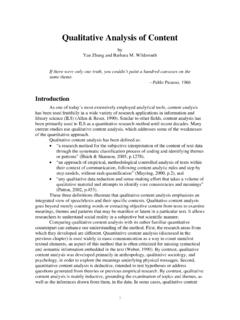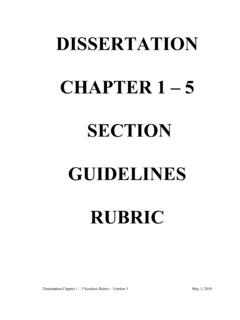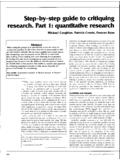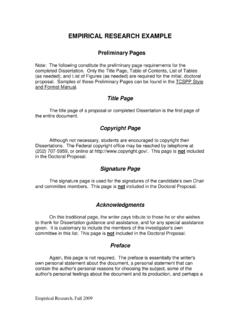Transcription of School Culture: Teachers' Beliefs, Behaviors, and ...
1 Australian Journal of Teacher EducationVolume 39|Issue 5 Article 52014 School Culture: Teachers' Beliefs, Behaviors, andInstructional PracticesChantarath HongboontriMahidol University, KeawkhongThis Journal Article is posted at Research CitationHongboontri, C., & Keawkhong, N. (2014). School Culture: Teachers' Beliefs, Behaviors, and Instructional of Teacher Education, 39(5).Retrieved from Journal of Teacher Education Vol 39, 5, May 2014 66 School Culture: Teachers Beliefs, Behaviours, and Instructional Practices Chantarath Hongboontri Natheeporn Keawkhong Mahidol University, Thailand Abstract: This mixed-methods research project documents the School culture of Hope University s Language Institute and reveals the reciprocal relationship between the School culture and the instructional practices of the English as a foreign language (EFL) teachers in this particular institute.
2 Altogether, 62 EFL teachers agreed to complete a questionnaire. Of these, 14 participated in semi-structured interviews and classroom observations; 2 agreed to be interviewed but did not allow their classrooms to be observed. quantitative data demonstrated strong correlations among eight social organizational variables of a School culture. Qualitative data further revealed the influences of a School culture on these teacher participants instructional practices. Introduction School cultures are unique and distinctive. They are created and re-created by people considered members of a context; , teachers, students, parents, and communities, among many others.
3 Deal and Peterson (1999) defined that School cultures as a collection of traditions and rituals that have been built up over time as teachers, students, parents, and administrators work together and deal with crises and accomplishments (p. 4). School cultures are influential. They shape and re-shape what people do, think, and feel (Beaudoin & Taylor, 2004; Cooper, 1988; Craig, 2009; Deal & Peterson, 1999, 2009; Guise, 2009; Hongboontri, 2003; Hongboontri & Chaokongjakra, 2011; Jurasaite-Harbinson & Rex, 2010; Kleinsasser, 1993, 2013; Lieberman, 1988, 1990; Maslowski, 2001; McLaughlin, 1993; Muhammad, 2009; Rosenholtz, 1991; Sato & Kleinsasser, 2004; Schien, 2010).
4 Rosenholtz s (1991) quantitative and qualitative study of elementary School teachers in America convincingly demonstrated how School cultures molded these teachers. With data gathered from 1,213 completed questionnaires and 74 interviews, Rosenholtz identified two types of School cultures; , nonroutine/certain and routine/uncertain. In the nonroutine/certain environment, teachers worked collaboratively, were involved in goal setting, and had opportunities for professional development. These, in turn, maximized students academic growth. In contrast, teachers in the routine/uncertain environment worked in isolation, had little (or almost no) involvement in School goal setting, and had fewer opportunities for professional development.
5 Students performances were, as a consequence, minimized. The influences of School cultures on teachers have also been extensively covered in the field of foreign language (FL) education. Kleinsasser s (1993) findings of his triangulated study with 37 FL teachers in five School districts in America emphasized the power of School cultures. Similar to Rosenholtz (1991), Kleinsasser found two types of School cultures: nonroutine/certain Australian Journal of Teacher Education Vol 39, 5, May 2014 67 and routine/uncertain. The nonroutine/certain culture promoted, Kleinsasser explained further, collaboration within a community.
6 In other words, his participating FL teachers collaborated not only with their colleagues in the FL department but they also worked with teachers from other subject disciplines, students, parents, administrators, and communities. Through collaboration, these FL teachers could create a successful learning environment where their students had the opportunity to use the second language for communication. On the contrary, in the routine/uncertain culture where collaboration was scarce (or almost nonexistent), the FL teachers not only individually planned their own instructions but also pursued different goals of teaching and learning.
7 Classroom instructions were mostly text driven and focused largely on grammar; students had little (or almost no) opportunity to use the second language for communication. Several years later, two doctoral students of Kleinsasser similarly investigated the School cultures in two different learning contexts (Japan and Thailand). Their findings echoed those of Kleinsasser (1993) despite their differences in the study contexts and the nature of the research participants. Sato s (2000) triangulated study of 19 English as a foreign language (EFL) teachers in one high School in Japan revealed the presence of a routine/uncertain School culture.
8 In this particular high School , collaboration was scant; these participating teachers worked in isolation. Their instructions followed the content in the textbooks to prepare students for the exams. Interaction between teachers and students and among students themselves was limited; seatwork exercises and rote-learning activities were oftentimes implemented in EFL classrooms. (See also Kleinsasser & Sato, 2007 and Sato & Kleinsasser, 2004 for more details.) Hongboontri (2003) went into one Thai university to document its School culture. By triangulating his gathered data, Hongboontri identified the existence of a routine/uncertain culture within this particular university.
9 These teachers admitted that they rarely collaborated with other teachers; they had no shared goals, and their learning opportunities were meager. Because of these factors, their instructions not only adhered to the assigned textbooks but also mainly emphasized discrete grammar points. Classroom interaction was rare as students were oftentimes individually involved with their grammar-oriented seatwork exercises. Hence, students opportunity to use English for communication was nonexistent. (See also Hongboontri, 2006a, 2006b, 2007, 2008.) Studies of Kleinsasser (1993), Sato (2000 [also Kleinsasser & Sato, 2007 and Sato & Kleinsasser, 2004]), and Hongboontri (2003) offered some insights into the influential roles of School cultures on FL and EFL teachers.
10 Nevertheless, more studies are still needed to understand the complexities of School cultures and their reciprocal relationship with FL and EFL teachers beliefs, behaviors, and instructional practices. Kleinsasser and Sato s (2007) quotation was worth mentioning despite its length. With these ideas of practice and professional development in mind we need to encourage further study of participants, contexts, professional development. We also need to make sure that future studies qualify terms that adequately and adroitly situate people, places, and their participant(s) in practice.

















